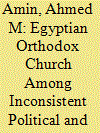| Srl | Item |
| 1 |
ID:
174374


|
|
|
|
|
| Summary/Abstract |
Beginning with the uprising in 2011 and until the reelection of President Abdel Fattah El-Sisi in 2018 for a second term, the Egyptian Orthodox Church has been an important player as the representative of the Coptic Christians in the country. This article examines the role of the Egyptian Orthodox Church since the establishment of the republic in 1952 and explores the historical events that sought to redefine the role of the Church in the political sphere. Unlike the previous studies focusing on Coptic Christians and their position in the sociopolitical contexts, this study tackles the political role of the Orthodox Church in its institutional capacity. The study concludes that the Egyptian Orthodox Church has turned into an important political player in the political sphere, and its political role increased substantially with the uprising. Its power is manifested in its support for the political transformations in 2013 and the backing the regime until today.
|
|
|
|
|
|
|
|
|
|
|
|
|
|
|
|
| 2 |
ID:
190802


|
|
|
|
|
| Summary/Abstract |
Due to their important role as the “revolutionary youth” (shabāb al-thawra) in the 2011 Egyptian revolution (known in part as the Arab Spring), they have attracted considerable attention from scholars. In the post-revolution era, discourse on the revolutionary youth has become prominent in Egypt. Compared to the social exclusion of the youth before 2011, it is noteworthy that the revolutionary youth emerged as the main focus of the interfaith relations between Muslims and Coptic Christians. Based on field research data, this article argues that since 2011, the “revolutionary youth” has become a new driving force of the solidarity movement among different sections of society, particularly interfaith harmony. By and large, the interfaith movement can be seen as an activist movement to maintain one’s ongoing revolutionary spirit by living differently. As a part of the global generation, Egyptian youth have been transformed by the revolution experience within the context of their historical–social location.
|
|
|
|
|
|
|
|
|
|
|
|
|
|
|
|